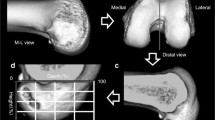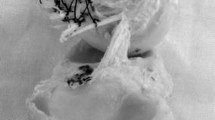Abstract
Purpose
The quadrant method is used to evaluate the bone tunnel position with the grid based on the Blumensaat’s line in anterior cruciate ligament (ACL) reconstruction. This study aimed to clarify the influence of variation in the Blumensaat’s line on the accuracy of the quadrant method measurements.
Methods
A retrospective review of the radiological records of patients aged 18–30 years who underwent computed tomography (CT) scanning of the knee joint was conducted. The Blumensaat’s line inclination angle (BIA), along with the most posterior point of the posterior condyle (point P) position using the quadrant method and morphology of the Blumensaat’s line were measured on true lateral transparent three-dimensional CT images of the distal femoral condyle in 147 patients. Statistical analysis was conducted to determine associations among these measurements.
Results
BIA was 37.5° (standard deviation 4.2°; range 27°–48°). The point P position was significantly correlated with BIA in the high/low (R2 = 0.590, P < 0.0001) and deep/shallow (R2 = 0.461, P < 0.0001) directions. The morphology of the Blumensaat’s line was straight in 35 knees (23.8%); whereas, the remaining 112 knees (76.2%) were not straight but had some hill on the Blumensaat’s line. No significant difference among the morphological variation of the Blumensaat’s line was observed in BIA and the point P position.
Conclusion
There was a strong correlation between BIA and the point P measured using the quadrant method, suggesting the influence of the Blumensaat’s line on the accuracy of the quadrant method measurements in ACL reconstruction. As for the clinical relevance, surgeons should be careful in application of the quadrant method for ACL reconstruction, because the variation of the Blumensaat’s line inclination influences the accuracy of this method.







Similar content being viewed by others
References
Al-Saeed O, Brown M, Athyal R, Sheikh M (2013) Association of femoral intercondylar notch morphology, width index and the risk of anterior cruciate ligament injury. Knee Surg Sports Traumatol Arthrosc 21:678–682
Amis AA, Jakob RP (1998) Anterior cruciate ligament graft positioning, tensioning and twisting. Knee Surg Sports Traumatol Arthrosc 6:S2–S12
Anderson AF, Lipscomb AB, Liudahl KJ, Addlestone RB (1987) Analysis of the intercondylar notch by computed tomography. Am J Sports Med 15:547–552
Bernard M, Hertel P (1996) Intraoperative and postoperative insertion control of anterior cruciate ligament-plasty. A radiologic measuring method (quadrant method). Unfallchirurg 99:332–340
Bernard M, Hertel P, Hornung H, Cierpinski T (1997) Femoral insertion of the ACL. Radiographic quadrant method. Am J Knee Surg 10:14–21 (discussion 21-12)
Bouras T, Fennema P, Burke S, Bosman H (2018) Stenotic intercondylar notch type is correlated with anterior cruciate ligament injury in female patients using magnetic resonance imaging. Knee Surg Sports Traumatol Arthrosc 26:1252–1257
Buzzi R, Zaccherotti G, Giron F, Aglietti P (1999) The relationship between the intercondylar roof and the tibial plateau with the knee in extension: relevance for tibial tunnel placement in anterior cruciate ligament reconstruction. Arthroscopy 15:625–631
Cole J, Brand JC Jr, Caborn DN, Johnson DL (2000) Radiographic analysis of femoral tunnel position in anterior cruciate ligament reconstruction. Am J Knee Surg 13:218–222
Colombet P, Robinson J, Christel P, Franceschi JP, Djian P, Bellier G et al (2006) Morphology of anterior cruciate ligament attachments for anatomic reconstruction: a cadaveric dissection and radiographic study. Arthroscopy 22:984–992
Forsythe B, Kopf S, Wong AK, Martins CA, Anderst W, Tashman S et al (2010) The location of femoral and tibial tunnels in anatomic double-bundle anterior cruciate ligament reconstruction analyzed by three-dimensional computed tomography models. J Bone Jt Surg Am 92:1418–1426
Inderhaug E, Larsen A, Strand T, Waaler PA, Solheim E (2016) The effect of feedback from post-operative 3D CT on placement of femoral tunnels in single-bundle anatomic ACL reconstruction. Knee Surg Sports Traumatol Arthrosc 24:154–160
Inoue M, Tokuyasu S, Kuwahara S, Yasojima N, Kasahara Y, Kondo E et al (2010) Tunnel location in transparent 3-dimensional CT in anatomic double-bundle anterior cruciate ligament reconstruction with the trans-tibial tunnel technique. Knee Surg Sports Traumatol Arthrosc 18:1176–1183
Iriuchishima T, Ryu K, Aizawa S, Fu FH (2016) Blumensaat’s line is not always straight: morphological variations of the lateral wall of the femoral intercondylar notch. Knee Surg Sports Traumatol Arthrosc 24:2752–2757
Jacobsen K, Bertheussen K, Gjerloff CC (1974) Characteristics of the line of Blumensaat. An experimental analysis. Acta Orthop Scand 45:764–771
Khalfayan EE, Sharkey PF, Alexander AH, Bruckner JD, Bynum EB (1996) The relationship between tunnel placement and clinical results after anterior cruciate ligament reconstruction. Am J Sports Med 24:335–341
Kim DH, Lim WB, Cho SW, Lim CW, Jo S (2016) Reliability of 3-dimensional computed tomography for application of the bernard quadrant method in femoral tunnel position evaluation after anatomic anterior cruciate ligament reconstruction. Arthroscopy 32:1660–1666
Kopf S, Forsythe B, Wong AK, Tashman S, Anderst W, Irrgang JJ et al (2010) Nonanatomic tunnel position in traditional transtibial single-bundle anterior cruciate ligament reconstruction evaluated by three-dimensional computed tomography. J Bone Jt Surg Am 92:1427–1431
Lee S, Kim H, Jang J, Seong SC, Lee MC (2012) Intraoperative correlation analysis between tunnel position and translational and rotational stability in single- and double-bundle anterior cruciate ligament reconstruction. Arthroscopy 28:1424–1436
Lertwanich P, Martins CA, Asai S, Ingham SJ, Smolinski P, Fu FH (2011) Anterior cruciate ligament tunnel position measurement reliability on 3-dimensional reconstructed computed tomography. Arthroscopy 27:391–398
Luites JWH, Verdonschot N (2017) Radiographic positions of femoral ACL, AM and PL centres: accuracy of guidelines based on the lateral quadrant method. Knee Surg Sports Traumatol Arthrosc 25:2321–2329
Moloney G, Araujo P, Rabuck S, Carey R, Rincon G, Zhang X et al (2013) Use of a fluoroscopic overlay to assist arthroscopic anterior cruciate ligament reconstruction. Am J Sports Med 41:1794–1800
Musahl V (2005) Varying femoral tunnels between the anatomical footprint and isometric positions: effect on kinematics of the anterior cruciate ligament-reconstructed knee. Am J Sports Med 33:712–718
Paley D (2002) Principles of deformity correction. Springer, Berlin
Parkinson B, Robb C, Thomas M, Thompson P, Spalding T (2017) Factors that predict failure in anatomic single-bundle anterior cruciate ligament reconstruction. Am J Sports Med 45:1529–1536
Piefer JW, Pflugner TR, Hwang MD, Lubowitz JH (2012) Anterior cruciate ligament femoral footprint anatomy: systematic review of the 21st century literature. Arthroscopy 28:872–881
Sadoghi P, Kropfl A, Jansson V, Muller PE, Pietschmann MF, Fischmeister MF (2011) Impact of tibial and femoral tunnel position on clinical results after anterior cruciate ligament reconstruction. Arthroscopy 27:355–364
Samora W, Beran MC, Parikh SN (2016) Intercondylar roof inclination angle: is it a risk factor for ACL tears or tibial spine fractures? J Pediatr Orthop 36:e71–e74
Scheffel PT, Henninger HB, Burks RT (2013) Relationship of the intercondylar roof and the tibial footprint of the ACL: implications for ACL reconstruction. Am J Sports Med 41:396–401
Shafizadeh S, Balke M, Kelz S, Hoeher J, Banerjee M (2014) Low inter- and intraobserver variability allows for reliable tunnel measurement in ACL reconstruction using the quadrant method. Arch Orthop Trauma Surg 134:529–536
Siebold R, Ellert T, Metz S, Metz J (2008) Femoral Insertions of the anteromedial and posterolateral bundles of the anterior cruciate ligament: morphometry and arthroscopic orientation models for double-bundle bone tunnel placement—a cadaver study. Arthroscopy 24:585–592
Sommer C, Friederich NF, Muller W (2000) Improperly placed anterior cruciate ligament grafts: correlation between radiological parameters and clinical results. Knee Surg Sports Traumatol Arthrosc 8:207–213
Tsuda E, Ishibashi Y, Fukuda A, Yamamoto Y, Tsukada H, Ono S (2010) Tunnel position and relationship to postoperative knee laxity after double-bundle anterior cruciate ligament reconstruction with a transtibial technique. Am J Sports Med 38:698–706
van Eck CF, Martins CA, Vyas SM, Celentano U, van Dijk CN, Fu FH (2010) Femoral intercondylar notch shape and dimensions in ACL-injured patients. Knee Surg Sports Traumatol Arthrosc 18:1257–1262
Yahagi Y, Iriuchishima T, Horaguchi T, Suruga M, Tokuhashi Y, Aizawa S (2018) The importance of Blumensaat’s line morphology for accurate femoral ACL footprint evaluation using the quadrant method. Knee Surg Sports Traumatol Arthrosc 26:455–461
Yasuda K, Kondo E, Ichiyama H, Kitamura N, Tanabe Y, Tohyama H et al (2004) Anatomic reconstruction of the anteromedial and posterolateral bundles of the anterior cruciate ligament using hamstring tendon grafts. Arthroscopy 20:1015–1025
Yasuda K, Kondo E, Ichiyama H, Tanabe Y, Tohyama H (2006) Clinical evaluation of anatomic double-bundle anterior cruciate ligament reconstruction procedure using hamstring tendon grafts: comparisons among 3 different procedures. Arthroscopy 22:240–251
Zantop T, Diermann N, Schumacher T, Schanz S, Fu FH, Petersen W (2008) Anatomical and non-anatomical double-bundle anterior cruciate ligament reconstruction: importance of femoral tunnel location on knee kinematics. Am J Sports Med 36:678–685
Zavras TD, Race A, Amis AA (2005) The effect of femoral attachment location on anterior cruciate ligament reconstruction: graft tension patterns and restoration of normal anterior-posterior laxity patterns. Knee Surg Sports Traumatol Arthrosc 13:92–100
Acknowledgements
The authors thank the staff at Department of Orthopaedic Surgery in NTT East Japan Sapporo Hospital for their contribution to this clinical study.
Funding
This study was financially supported by a graft from NTT East Japan Sapporo Hospital.
Author information
Authors and Affiliations
Contributions
KI collected the data, made the analysis and drafted the work. MI conducted this study, supervised the data analysis and completed the draft. YK supported the data collection. KT and HK contributed to taking special CT images. IY advised the statistical analysis. EK, NI and KY interpreted the data and revised the draft critically.
Corresponding author
Ethics declarations
Conflict of interest
The authors declare no conflicts of interest associated with this manuscript.
Ethical approval
Ethical approval was given by Institutional review board (IRB) of Hokkaido University Hospital (IRB number, 017-063).
Additional information
Publisher's Note
Springer Nature remains neutral with regard to jurisdictional claims in published maps and institutional affiliations.
Rights and permissions
About this article
Cite this article
Iwasaki, K., Inoue, M., Kasahara, Y. et al. Inclination of Blumensaat’s line influences on the accuracy of the quadrant method in evaluation for anterior cruciate ligament reconstruction. Knee Surg Sports Traumatol Arthrosc 28, 1885–1893 (2020). https://doi.org/10.1007/s00167-019-05619-8
Received:
Accepted:
Published:
Issue Date:
DOI: https://doi.org/10.1007/s00167-019-05619-8




